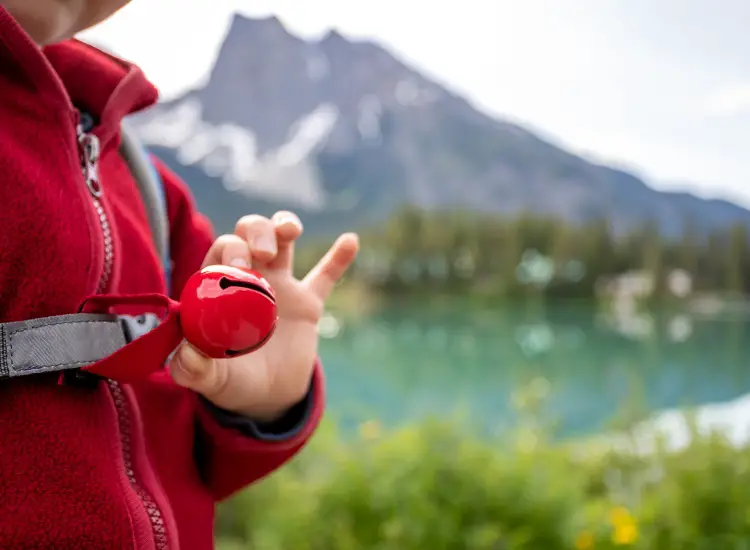Do Bear Bells Work? The Truth Revealed

You’re out in the backcountry, enjoying a peaceful hike, when suddenly you hear a rustling in the bushes. Your heart starts racing – could it be *gasp* a bear? In situations like these, it’s natural to want to take precautions to stay safe. One popular method is using bear bells. But do they actually work?
In this article, we’ll dive into the effectiveness of bear bells in deterring bears and keeping you safe on your outdoor adventures. We’ll explore the science behind the concept, discuss the pros and cons of using bear bells, and provide some alternative strategies to consider. So, let’s find out if bear bells are a helpful tool or just a jingly accessory!
Quick Links
How Do Bear Bells Work?
Bear bells are a common tool used by hikers and campers in bear country to alert bears of their presence and prevent surprise encounters. These small bells are typically attached to backpacks, clothing, or hiking poles, and produce a constant jingling sound while in motion. The idea behind bear bells is that the sound they produce will alert bears to the presence of humans, giving them a chance to avoid human interaction. Here are some key points on how bear bells work:
- Sound: The jingling sound produced by the bear bells is intended to mimic the sound of prey or other animals moving through the environment. This can trigger the bear’s natural avoidance response as they associate the sound with potential danger.
- Constant Noise: The continuous noise generated by the bear bells provides a persistent indication of human presence, making it less likely for bears to be surprised by a sudden encounter.
- Sound Carries: The sound of the bear bells can carry over longer distances, potentially alerting bears in the vicinity to the presence of humans from afar.
- Proximity Warning: The noise of the bear bells can act as a proximity warning system, alerting bears that humans are near and giving them an opportunity to leave the area before any potential conflict arises.
- Human Cycling: The rhythmic sound created by the bear bells as hikers or campers move can also signal to bears that the humans are not stationary or hiding, further reducing the likelihood of surprise encounters.
While bear bells can be a useful tool for bear safety, it is important to remember that they are not guaranteed to prevent all bear encounters. It is essential to practice other bear safety measures, such as making noise, traveling in groups, carrying bear spray, and being aware of bear behaviors and signs in the area. Additionally, it is crucial to consult and follow any specific bear safety guidelines or recommendations provided by local authorities or park rangers when venturing into bear country.
Effectiveness of Bear Bells in Preventing Bear Encounters
The effectiveness of bear bells in preventing bear encounters is a topic of debate and ongoing research. Let’s explore the current understanding of how bear bells work and their effectiveness in deterring bears.
How Do Bear Bells Work?
Bear bells are typically designed to create noise as the hiker moves. The jingling or tinkling sound produced by the bear bell is intended to alert bears in the vicinity that humans are present. The theory behind this is that bears will hear the sound and avoid the area, reducing the likelihood of a surprise encounter.
Attached to a backpack or worn on clothing, bear bells are designed to produce a constant, rhythmic noise as the hiker moves. It is believed that the sound of the bear bell will be enough to warn bears of human presence, allowing them to move away from the area without conflict.
However, the exact range and effectiveness of the sound produced by bear bells is still debated and subject to further research.

Alternatives to Bear Bells for Bear Deterrence
While bear bells are commonly used as a method of bear deterrence during outdoor activities, there are alternative options that can also be effective in deterring bears. It’s important to choose a method that aligns with your preferences and the specific circumstances of your outdoor adventure. Here is a paragraph followed by a bullet list of alternatives to bear bells for bear deterrence:
- Bear Spray: A canister of bear spray can provide a potent deterrent against bear encounters. It releases a cloud of pepper spray that temporarily impairs a bear’s ability to see and breathe, giving you time to retreat safely.
- Air Horn: An air horn can startle bears and discourage them from approaching. The loud sound can disrupt their behavior and cause them to retreat.
- Bear Whistles: Similar to a regular whistle, bear whistles emit a high-pitched sound that can alert bears to your presence. They are lightweight and easy to carry.
- Human Voice: Making loud noises or shouting can help alert bears to your presence and deter them from approaching. Use caution and be aware of your surroundings. But yes – this does mean constant noise (which, let’s face it – in nature you typically want some peace and solitude.)
- Proper Food Storage: Keeping food and other bear attractants stored securely can reduce the likelihood of bear encounters. Use bear-resistant containers or hang food from a tree branch at a safe distance from your camping area. Learn more about hiking with food in bear country.
- Group Travel: Traveling in a group can increase safety by making you appear larger and more intimidating to bears. Bears are generally more hesitant to approach larger groups of people.
Remember, it’s important to research and understand the best practices for bear safety in your specific location. Different bear species and regions may have varying behaviors and responses to deterrence methods.
Tips for Using Bear Bells Properly
To ensure the effectiveness of bear bells, follow these tips:
- Attach the bell securely: Make sure the bear bell is securely attached to your backpack, clothing, or hiking gear to ensure it doesn’t fall off during your outdoor activities.
- Keep the bell ringing: Keep the bell ringing consistently as you hike or move through bear country. The sound will help alert bears to your presence and give them a chance to move away.
- Position the bell where it can be heard: Place the bear bell where it can produce a clear sound, such as on the outside of your backpack or on your shoe laces. This will help ensure that the sound travels and can be heard by bears in the area.
- Use multiple bells: Consider using multiple bear bells to increase the sound and make it more noticeable to bears. You can attach bells to different areas of your gear or clothing for maximum effect.
- Combine with other deterrents: Bear bells work best when used in combination with other bear deterrents, such as bear spray or air horns. These additional measures can help enhance your safety in bear country.
Remember, while bear bells can be a useful tool, it’s important to remain vigilant and follow proper bear safety guidelines while exploring bear habitat. Stay informed about local bear activity and be prepared for encounters by carrying bear spray, making noise, and being aware of your surroundings.
Pros and Cons of Bear Bells for Hiking and Camping
While bear bells can be effective in certain situations, they also have their limitations. Here are some pros and cons to consider when using bear bells:
Pros of Bear Bells
- Alerting bears: Bear bells can make noise while hiking or camping, alerting bears of human presence. This can potentially reduce the likelihood of unexpected encounters and give bears an opportunity to avoid humans.
- Easy to use: Bear bells are lightweight and easy to attach to backpacks or clothing. You don’t have to think about. Just attach it and go.
- Non-lethal: Bear bells provide a non-lethal method of bear deterrence. They are considered a more humane option compared to other bear deterrents, such as pepper spray.
Cons of Bear Bells
- Inconsistent effectiveness: The effectiveness of bear bells in preventing bear encounters is not guaranteed. Just like with human food, some studies suggest that bears may become habituated to the sound of bear bells over time, rendering them less effective.
- Noisy hiking experience: The continuous jingling of bear bells can be disruptive and detract from the peaceful hiking experience. Some hikers may find the noise irritating or distracting. Like I said – sometimes you just want to hear the sounds of nature (and not a noisy bell.)
- Not effective in certain situations: Bear bells may be less effective in windy conditions or areas with dense vegetation, as the sound may not carry far enough to alert nearby bears.
While bear bells can provide an additional layer of safety during hiking and camping trips, they should not be solely relied upon. It is important to follow other best practices for bear safety, such as properly storing food, being aware of bear signs and behavior, and knowing how to respond in the event of a bear encounter.
Evidence and Research Supporting the Use of Bear Bells
Bear bells have been a popular tool for hikers and campers in bear country for many years, but does the evidence support their effectiveness? Let’s take a look at the research and findings regarding the use of bear bells for bear deterrence.
Studies on Bear Bell Effectiveness
Several studies have been conducted to evaluate the effectiveness of bear bells in preventing bear encounters. One study published by the University of Calgary looked into many bear deterrents, including bells. Here is what they found:
In addition, Jope, who conducted the study, also mentioned a few key facts to reduce encounters with aggressive grizzly bears:
- Regular and irregular encounters between humans and bears should take place to habituate the bears to the presence of humans.
- Employ easily recognizable stimuli, such as bear bells, to warn bears and announce human presence.
- Hikers or bikers should exhibit innocuous behavior, avoiding food giving or aggressive behavior during encounters.
Considerations and Limitations
While the evidence and research generally support the effectiveness of bear bells, it’s important to note some considerations and limitations. First, bears can become habituated to certain stimuli over time, including the sound of bear bells. This means that the effectiveness of bear bells may vary depending on the behavior and previous experiences of the bears in a specific area.
Secondly, according to the study, there are even more limitations to bear bells. Their sound carrying distance is limited, and environmental factors like rushing water, wind, and thick foliage can mask or degrade the sound of the bells. This reduction in sound carrying distance could increase the risk of encounters with bears. The study also suggests that the bear bells currently sold to hikers are inadequate for effectively warning bears.
Common Misconceptions About Bear Bells
When it comes to hiking or camping in bear country, there are several common misconceptions about the effectiveness of bear bells. Understanding these misconceptions can help you make informed decisions about bear safety. Here is a brief paragraph followed by a bullet list of common misconceptions about bear bells:
- Bear bells guarantee 100% bear deterrence: While bear bells can be a useful tool, it is important to remember that they are not foolproof. Bears may still approach despite the noise, especially if they are surprised or have not been habituated to associate the sound with humans.
- Bear bells eliminate the need for other bear safety practices: Bear bells should not be relied upon as the sole form of bear deterrent. It is essential to follow other recommended practices such as carrying bear spray, properly storing food, and being aware of your surroundings.
- All bear bells are equally effective: Not all bear bells are created equal. As mentioned in the study, some may produce louder or more attention-grabbing sounds, while others may be less effective. It is important to choose a bear bell that is designed specifically for bears and has been proven to be effective.
- Bear bells are always heard by bears: While it is believed that bears have good hearing, there is no guarantee that they will always hear the sound of a bear bell, especially in certain environmental conditions or if the bell is not properly attached or positioned.
- Bear bells prevent all bear encounters: While bear bells can help reduce the likelihood of surprise encounters, they do not guarantee complete avoidance of bear encounters. It is crucial to remain vigilant, make noise while hiking, and be prepared to react appropriately if you do encounter a bear.
By understanding these common misconceptions, you can use bear bells as part of a comprehensive bear safety strategy and make more informed decisions while exploring bear country. In the next section, we will discuss best practices for bear safety that go beyond relying solely on bear bells.
Best Practices for Bear Safety in Bear Country
With all that said, I’ll let you choose if you decide to wear a bear bell or not. However, here are some final tips & reminders to stay safe in bear territory:
- Stay alert and make noise: Bears are more likely to avoid humans if they are aware of their presence. Make noise while hiking by talking, singing, or using bear bells to alert bears to your presence.
- Store food properly: Bears are often attracted to the smell of food. Store food and scented items in bear-resistant containers, or hang them high out of a bear’s reach.
- Carry bear spray: Bear spray can be an effective deterrent in the event of a bear encounter. Familiarize yourself with how to use it properly and always have it easily accessible.
- Travel in groups: Bears are less likely to approach a larger group of people. Stick together when hiking or camping in bear country.
- Stay on designated trails: Stick to established trails and avoid venturing into dense vegetation or areas with limited visibility where bears may be present.
- Be mindful of bear signs: Pay attention to signs of bear activity, such as fresh tracks, scat, or overturned rocks or logs. These signs can indicate that bears are in the area.
- Give bears space: If you encounter a bear, give it plenty of space and back away slowly. Never approach or try to feed a bear. While black bears are generally considered to be more passive than grizzly bears, that doesn’t mean you should try and pet one.
- Know how to react during an encounter: Familiarize yourself with the appropriate actions to take in a bear encounter, such as standing your ground, speaking calmly, and slowly backing away.
- Stay updated on local bear activity: Check with local authorities or park rangers for information on recent bear sightings or bear activity in the area you plan to visit.
- Be prepared for emergencies: Carry a first aid kit, know how to navigate and find your way back, and inform someone of your travel plans and expected return time.
By following these best practices, you can minimize the risk of bear encounters and ensure a safe and enjoyable outdoor experience in bear country.
Conclusion
While bear bells can be a useful tool in alerting bears of human presence and potentially preventing surprise encounters, they are not guaranteed to prevent all bear encounters. It is important to remember that bear bells should be used in combination with other bear safety practices, such as making noise, traveling in groups, carrying bear spray, and being aware of bear behavior and signs in the area. Additionally, it is crucial to consult and follow any specific bear safety guidelines or recommendations provided by local authorities or park rangers when venturing into bear country.
By being informed, prepared, and proactive in your approach to bear safety, you can minimize the risk of bear encounters and enjoy your outdoor adventures with peace of mind. Remember to prioritize safety, follow best practices, and stay vigilant while exploring bear country.







